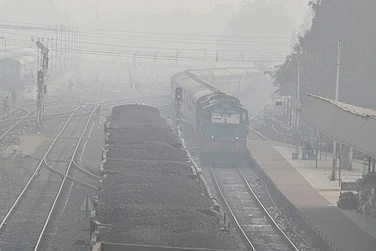As a resident of India's capital, the Delhiite is on the odd occasion proud of his city. This is possibly because he doesn't know that, in Delhi, stray cows are held in more esteem than his children. In 2001, the Delhi government spent Rs 4,416 on a cow, more than the per student expenditure at a government school. The total amount spent on the animals was Rs 1.5 crore, money that would have gone some way to building a school for the city's 5 lakh slum children.
Despite having a per capita income three times the national average and the best financial infrastructure, Delhi is growing into an urban jungle. A population touching 14 million, half of them migrant, is pouring out of its seams. Result: urban facilities are stretched, administrative corruption rampant and citizens are either helpless or apathetic.
But the citizen, in lieu of the taxes he/ she pays, has the right to efficient amenities, law and order and a clean environment. And the most important thing needed to exercise that right is information—about the many tentacles of government, how they function and the quality of their work. To guide the Delhiite, the Centre for Civil Society, a think-tank working for citizens' rights, has come out with an efficient handbook. A research project involving a score of fresh graduates, it has unearthed some shocking facts to possibly shake the common man out of his reverie.
For instance, take the fact that the Delhiite exposes himself to serious hazards when he goes out to buy food. There are only 28 inspectors in the prevention of food adulteration department—the number is the same as it was in 1960—to inspect over 1.5 lakh registered food establishments. Even at two outlets per inspector a day, a restaurant would be inspected only once in eight years! And don't forget the 3.5 lakh unlicensed food outlets.
Why are vegetables so abundant, yet so expensive here unlike in other cities? Farmers pay 7-15 per cent of sales as commission to licensed agents at wholesale markets that are the monopoly of the Delhi Agricultural Marketing Board (DAMB) plus a one per cent transaction fee to the market. The Azadpur market farmers, for instance, pay Rs 4.42 crore to the DAMB. (See box for more examples.)
The city produces 6,500-7,500 tonnes of garbage everyday but despite 36 garbage workers per 10,000 people, compared to 18-20 for Mumbai, Calcutta or Chennai, it looks as filthy as ever. The state runs over 76 per cent of the schools, but private unaided schools have taken away a third of the total students. And why not? A study conducted by Social Jurist found that over 80 per cent of the children in Class V of MCD schools could not even read or write their names.
Even our elected representatives are pretty much guilty of similar misdemeanours. Only half of the allocated funds of the MLA Development Funds were spent last fiscal. But, says Partha J. Shah, ccs president: "The Right to Information Act is your shortest road to a revolution in public governance, to an effective and limited government." Shah gives examples of how the Act was used by factory owners to slum-dwellers to get redressal from MCD, DVB and even the food supplies department.
Shah also suggests how city governance can be reformed. The first rule, he says, is "the rule of doctors: Do no harm. Likewise, don't obstruct". Review all laws that obstruct a person from earning an honest living or provide an essential service. Example, the need to get 14 licenses to open a school up to the eighth standard. Two, separate provision from production, and focus on the core function—contract out garbage disposal, issue food stamps, etc. Three, finance services through user fees (like water meters) instead of taxes that hit the non-user. Four, expand choice and competition.Fifth, give clean subsidies—pay per student scholarship to schools, instead of grants etc. Lastly, get a report card system in place. Let the citizens vote with their judgement, not by sitting at home on poll day.
Capital, Kaput
A citizen's handbook to take stock of the city's wrongs

Capital, Kaput
Capital, Kaput
Published At:
- Previous Story
 Day-II HIM MSME Fest 2026: Himachal Pradesh CM Chairs CEO’s Roundtable Conference
Day-II HIM MSME Fest 2026: Himachal Pradesh CM Chairs CEO’s Roundtable Conference - Next Story
MOST POPULAR
WATCH
MORE FROM THE AUTHOR
×





















